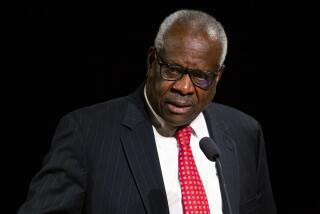U.S. Loses Appeal in S&L; Case : Thrifts: Court says government reneged on promises to industry. Ruling on Glenfed suit could cost U.S. billions.
- Share via
The federal government could be forced to pay billions of dollars to the thrift industry under a federal appeals court ruling Wednesday. The court said the U.S. government broke promises it made to the industry to enlist its help in the savings and loan crisis of the 1980s.
The court overwhelmingly upheld a lower court decision in a $1.5-billion lawsuit brought by Glendale Federal Bank, which claimed it nearly failed because the government reneged on its deal.
No specific damages were assessed, but the 9-2 ruling by the U.S. Court of Appeals for the Federal Circuit could set an important precedent for about 90 similar cases--including several involving California-based thrifts--now pending in federal courts. The government is considered likely to appeal to the U.S. Supreme Court, but the strong ruling could also pressure it to seek settlements.
The overall amount of damages at stake are difficult to estimate. Ricki Tigert Helfer, chairwoman of the Federal Deposit Insurance Corp., told a Senate panel last March that the cost to taxpayers could reach $4.9 billion from pending cases. Since then, however, many more claims have been filed.
“This case tests the basic American belief in fairness and the fundamental concept that ‘a deal is a deal,’ ” Stephen J. Trafton, GlenFed’s chairman and chief executive, said in a statement prepared in anticipation of the ruling.
Trafton, an avid outdoorsman, was mountain climbing in the Colorado Rockies when the decision came down Wednesday morning and was unaware of it until hours later, aides said.
The thrifts’ claims all center on “supervisory goodwill,” a bit of accounting sleight of hand invented by thrift regulators in the early 1980s as a means of enticing healthy savings and loans to take over failed or ailing institutions without a cash bailout from the federal Treasury.
In GlenFed’s case, it agreed in 1981 to absorb a Florida thrift with negative net worth of $734 million. Regulators signed a contract with GlenFed allowing it to offset the $734-million shortfall with a $734-million intangible asset called goodwill. GlenFed was promised it could carry the goodwill on its books as if it were capital, amortizing it over 40 years.
In hundreds of similar deals around the country, regulators approved an estimated $25 billion of supervisory goodwill.
But in the landmark thrift bailout legislation of 1989, Congress changed the rules, ordering the thrifts to write off the goodwill by Jan. 1, 1995.
The reversal wiped out millions of dollars of GlenFed’s capital at once and forced the thrift to go through a painful process of selling off assets and scrambling to attract new capital to replace the $565 million of goodwill that was still on its books, Richard Fink, senior executive vice president, said Wednesday.
GlenFed’s assets, which stood at $25 billion in 1989, dwindled to about $15 billion at the start of this year, and the bank came close to being seized in 1993, Fink said.
GlenFed’s suit seeks compensation not only for the goodwill but for the “opportunity costs” associated with having to shrink its business and unload assets, in some cases at fire-sale prices, Fink said.
Fink noted that GlenFed offered to settle the case two years ago by having the government invest in an issue of preferred stock that would have propped up the thrift’s capital base. Not only would the stock have paid dividends, but the government would have gotten its entire investment back as soon as GlenFed’s finances recovered sufficiently.
But the government turned down the deal. Now, Fink said, GlenFed wants cash compensation. GlenFed said it has “documented claims for damages in excess of $1.5 billion.”
California savings and loan stocks, already buoyant because of takeover speculation, soared on the appeals court news. Among the thrifts with lawsuits pending, GlenFed gained $1.875 to close at $16.625; California Federal Bank rose $1.625 to $15.875; Coast Savings Financial jumped $3.25 to $27, and H.F. Ahmanson & Co., parent of Home Savings of America, added $1 to $23.875.
The sharpest gain was in the novel “goodwill participation certificates” that CalFed issued earlier this year as a way to let investors speculate on its chances in court. The certificates, which represent a 25% interest in any cash award or settlement, nearly doubled, leaping $3.125 to $7.375.
During the 1980s, critics such as Bert Ely, a Virginia-based consultant, derided the government for creating “funny money” to paper over a problem that sooner or later would have to be solved with real cash.
Ely, in an interview Wednesday, said the appeals court decision further exposes “a classic case of denial” on the government’s part.
“The regulators and Congress were trying to sneak past the problem, and years later they got caught,” Ely said.
The appeals court decision only said that the government had breached its contract; it did not assess damages. That will happen at a lower-court level if and when the government exhausts its appeals.
“A lot of institutions did a lot of good for the taxpayers by taking over these thrifts,” said V. Gerard Comizio, a former lawyer for the Office of Thrift Supervision now in private practice in Washington. “This decision says the government has to honor its agreements.”
More to Read
Inside the business of entertainment
The Wide Shot brings you news, analysis and insights on everything from streaming wars to production — and what it all means for the future.
You may occasionally receive promotional content from the Los Angeles Times.










